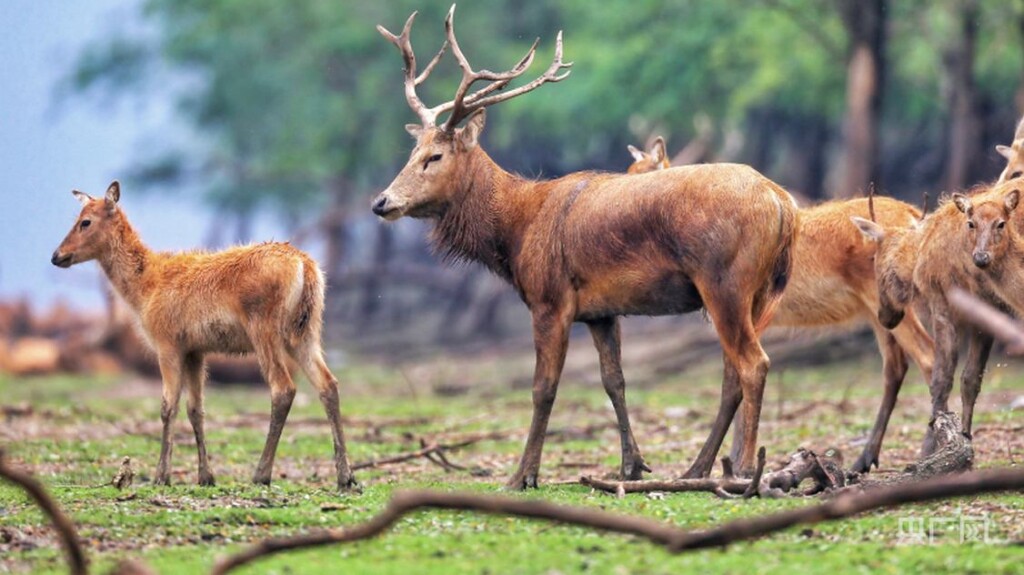Miracle Recovery For World’s Rarest And Strangest Deer – Just 39 Became 8,200

Tramping through coastal marshlands in eastern China, a strange looking deer roams freely in herds of hundreds; a remarkable recovery from where they had been just a few decades ago.
Described in ancient China as a beast with the antlers of a deer, hooves of an ox, face of a horse, and tail of a donkey, Père David’s deer was at one time the rarest of its kind on Earth.
Hunted to extinction in the wild 125 years ago, captive animals clung to life in a far away land, until in 1985, their descendants could return to a wiser China where a more eco-conscious population welcomed them home to the quiet marshlands.
In the early 20th century, the British nobleman and politician Herbrand Russell, 11th Duke of Bedford, acquired a few Père David’s deer from the Berlin Zoo and built up a large herd on his estate at Woburn Abbey.
In 1985 the duke’s great-grandson Robin Russell, 14th Duke of Bedford, donated 39 Père David’s deer to the Chinese government for a reintroduction program. They were placed in a park/reserve that once belonged exclusively for canned hunts conducted by the emperors in Beijing—the killing field had become a sanctuary.
A second re-introduction into China was conducted in 1986 where 36 Père David’s deer were chosen from five UK zoological gardens. From less than 100, these original animals have multiplied into 8,200 and seem—as if by a miracle—not be be suffering from low genetic diversity. They enjoy a 17% annual growth rate in the population.
Today, all of the deer that roam China are descended from Russel’s herd, and across China’s many elk sanctuaries like Tianezhou and Dafeng, dozens of square miles of pristine habitat are protected for this incredible animal. Plans are underway to reintroduce the deer to much more wild areas, where they will have to learn to avoid predators and battle the elements once again.
ALSO CHECK OUT: Kazakhstan Efforts to Restore Last Wild Equine Species Receive Huge Boost of 150 Horses
A Chinese-language moniker for the Père David’s deer translates to “the four dislikes” referring to the component appearance mentioned above. As is so often the case in Chinese society, this strangeness is paired with a legend.
The following was taken from Wikipedia,
According to Chinese legend, when the tyrant King Zhou of Shang ruled the land more than 3,000 years ago, a horse, a donkey, an ox and a deer went into a cave in the forest to meditate and on the day the King executed his minister Bigan, the animals awoke from their meditation and turned into humans.
MORE HANDSOME STAGS: Wild and Wonderful Saiga is No Longer Endangered with a Million Roaming Now in Central Asia
They entered society, learned of the King’s heinous acts and wanted to take recourse against the King, who was powerful. So they transformed themselves into one creature that combined the speed of the horse, the strength of the ox, the donkey’s keen sense of direction and the nimble agility of the deer.
This new animal then galloped to the Kunlun Mountains to seek the advice of the Primeval Lord of Heaven. The Lord was astonished at the sight of a creature that had antlers of a deer, hooves of an ox, face of a horse and tail of a donkey.
“It’s unlike any of four creatures!” he exclaimed. Upon learning of the animal’s quest, Lord gave his blessing and dispatched the creature to his disciple the sage Jiang Ziya, who was battling the King. Jiang Ziya rode the creature to victory over the King and helped found the Zhou dynasty.






Please be good and do not spam. Thank you.